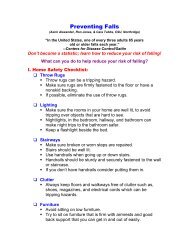Why Shoes Make “Normal” Gait Impossible - RonJones.Org
Why Shoes Make “Normal” Gait Impossible - RonJones.Org
Why Shoes Make “Normal” Gait Impossible - RonJones.Org
You also want an ePaper? Increase the reach of your titles
YUMPU automatically turns print PDFs into web optimized ePapers that Google loves.
<strong>“Normal”</strong> <strong>Gait</strong>...<br />
tremes of risk. Yet, that is exactly<br />
what happens because of the various<br />
tread faults of the shoes we<br />
wear.<br />
Sensory Response<br />
Podiatry, unfortunately, along<br />
with all the other medical specialties,<br />
has given little attention to the<br />
role of the earth’s bioelectromagnetic<br />
forces relative to sensory response<br />
of the foot, which bear enormous<br />
influence on gait. It is a field begging<br />
investigation by podiatry, because<br />
the foot is so intimately involved.<br />
The soles and tips of the toes<br />
contain over 200,000 nerve endings,<br />
perhaps the densest concentration<br />
to be found anywhere of<br />
comparable size on the body. Our<br />
nerve-dense soles are our only tactile<br />
contact with the physical<br />
world around us. Without them we<br />
would lose equilibrium and become<br />
disoriented. If the paws or<br />
feet of any animal were “desensitized,”<br />
the animal could not survive<br />
in its natural environment for<br />
an hour.<br />
Says orthopedist Philip Lewin,<br />
“The foot is the vital link between<br />
Fig. 23: Foot inside snug-fit<br />
shoe. Whole lateral rim of<br />
metatarsals and digits are<br />
pushed in by shoe, depriving<br />
them of normal function.<br />
Fig. 24: Left, dog has lower center<br />
of gravity and more than twice the<br />
base area beneath its body, allowing<br />
greater stability of weight distribution;<br />
right, man has much higher<br />
center of gravity and very small base<br />
for falling weight, making body balance<br />
and equilibrium much more<br />
fragile and requiring enormous<br />
skeletal and muscular support for<br />
stable stance and gait.<br />
the person and the earth, the vital<br />
reality of his day-to-day existence.”<br />
City College of New York<br />
anatomists Todd R. Olson and<br />
Michael E. Seidel write, “Because<br />
the sole is so abundantly supplied<br />
with tactile sensory nerve endings,<br />
we use our feet to furnish the brain<br />
with considerable information<br />
about our immediate environment.”<br />
Thus there is a sensory<br />
foot/body, foot/brain connection<br />
vital to body stability, equilibrium,<br />
and gait.<br />
Yet, much of it is denied us because<br />
of our thick-layered, inflexible<br />
shoes that shut off a considerable<br />
amount of this electromagnetic<br />
inflow and our sensory response<br />
to it. B. T. Renbourne, M.D., of<br />
England’s Brookside Hospital, has<br />
done considerable research in this<br />
field. He writes, “Modern shoes<br />
give good wear, but they also impair<br />
the foot’s sensory response to<br />
the ground and earth, affecting the<br />
reflex action of the foot and leg<br />
muscles in gait. This sensory foot<br />
contact is essential for stable, surefooted<br />
walking.”<br />
It is well known by both common<br />
experience and clinical test-<br />
ing that infants are able to walk<br />
with much more confidence and<br />
stability barefoot than with shoes<br />
on. In fact, the same can be said of<br />
adults. This is not only because of<br />
the foot’s biomechanics (flexing,<br />
toe grasping, heel-to-toe step sequence,<br />
etc.), but also because of<br />
the neural energy assist from the<br />
sensory response.<br />
However, when several layers of<br />
shoe bottom materials are packed<br />
between foot and ground, a certain<br />
amount of sensory blockage is inevitable,<br />
and the gait loses some of<br />
its natural energies and functional<br />
efficiency.<br />
The Role of Orthotics<br />
The foregoing comments concerning<br />
natural human gait require<br />
a completely fresh perspective<br />
concerning the use of foot orthotics—especially<br />
those designed<br />
to establish or re-establish “normal”<br />
foot balance and stability of<br />
gait.<br />
To put the conclusion first: natural<br />
gait is impossible for the shoewearing<br />
foot—at least shoes as traditionally<br />
designed and constructed.<br />
And it is equally impossible for any<br />
Continued on page 61<br />
60 PODIATRY MANAGEMENT • MARCH 1999













